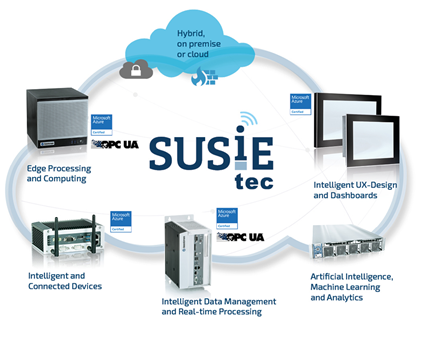
A growing demand calls for a growing supply as well. For some years now, more and more cloud service providers have been trying to make up ground against their competitors with an ever-growing range of services. When it comes to enterprise-level IaaS services, Amazon Web Services (AWS) is still the benchmark according to analysts. Nevertheless, Microsoft is also gaining ground with its growing Azure portfolio. And now, the IIoT framework SUSiEtec from Kontron and S&T Technologies is getting involved in global networking, too. But what can SUSiEtec do that others can't and does the new service have the potential to hold its own against the big cloud players?
The times when only cables were plugged together are finally over
There is no doubt about it: If you want to remain competitive, you will have to network. The market volume for cloud services is therefore constantly growing and it is becoming increasingly difficult for users to choose a cloud provider. Once system integrators start dealing with the subject, they quickly notice that large cloud providers are not prepared to respond to individual customer wishes. They only offer a basic product, individual extras are not included in the portfolio. However, the networking requirements vary greatly from customer to customer and from project to project. One of the biggest challenges at the beginning is that customers often do not know exactly where the journey will take them, what possibilities a cloud will provide and which data should be located where. The result is often complicated multi-cloud scenarios with several public cloud providers.
In view of this problem it becomes clear: SUSiEtec is indeed a real newcomer. Thanks to the combination of individual consulting, development services and established standard software, the range of software and services offered by SUSiEtec combines all the existing jigsaw pieces of a cloud solution and combines them into a complete package. SUSiEtec stands for "S&T's User Focused Solutions for IoT Embedded" and handles complete networking - including private/on-premise, public cloud integration and hosting. The platform is individually adapted to the specific application and is used at the interface between sensors and the cloud, you could call it middleware for the IoT. It functions as the link between devices, converts protocols, filters data and - if necessary - processes them directly on site. SUSiEtec is flexibly configurable and is individually adapted to existing automation solutions in order to collect and analyze control and sensor data on site. The service thus creates a fusion between computer technology, factory and corporate IT: a capability that is extremely rare and in great demand in the age of industry 4.0.
The Startkerkit is intended to make it easier for companies to enter edge, fog and cloud computing for use in their production or products. This includes four building blocks: The development of an individual catalogue of questions; the analysis and inventory; the development of a concrete concept as well as the presentation of an architectural concept, an estimate of effort and the timetable for implementation. Good analysis and planning are the basis of entrepreneurial success, after all.
From Edge to Fog to Cloud': That's why SUSiEtec is also suitable for cloud skeptics.
For many companies - not only in Germany - it still feels safer to store most of their data in-house. So instead of 'Everything in the Cloud', the motto 'Only what is necessary in the Cloud' applies much more. SUSiEtec supports Kontron's 'From Edge to Fog to Cloud' approach. This means that companies evaluate their data exactly where it makes the most sense. Further evaluations or historical data are moved to the cloud - provided there are no security concerns. At the edge of the network data is collected and evaluated and filtered by intelligent IoT devices. Only for further evaluation of important data are these forwarded to the 'embedded cloud' - i.e. the company-internal private cloud close to production. If necessary, filtered and less time-critical data can be moved to a public cloud. For companies, on the other hand, that want to adapt their entire application landscape to the new infrastructure, so-called container technology is used. With this technology - e.g. with Docker as the technology basis - the application and its dependencies are isolated and can then be moved from system to system (like a file) and run independently of the hardware.
Which cloud solution do you use? Would you have wished for a more individual adaptation to your corporate structures and needs in some places?


{{comment.comment}}